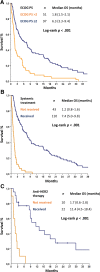Clinicopathological and Treatment-Associated Prognostic Factors in Patients with Breast Cancer Leptomeningeal Metastases in Relation to Tumor Biology
- PMID: 30120164
- PMCID: PMC6291333
- DOI: 10.1634/theoncologist.2018-0200
Clinicopathological and Treatment-Associated Prognostic Factors in Patients with Breast Cancer Leptomeningeal Metastases in Relation to Tumor Biology
Abstract
Background: Breast cancer (BC) is one of the solid tumors most commonly associated with leptomeningeal disease (LMD). LMD carries a devastating prognosis; however, disease presentation and prognostic factors are uncertain.
Subjects, materials, and methods: In order to describe patient characteristics, treatment patterns, and factors associated with survival in a contemporary multicentric cohort, 153 consecutive BC patients diagnosed with LMD at two European institutions (2002-2017) were included. Time to LMD and overall survival (OS) after LMD diagnosis were evaluated using the Kaplan-Meier method and Cox proportional hazards models.
Results: Median age at LMD diagnosis was 58 years (25-84). Tumor phenotype distribution was as follows: hormone receptor (HR) positive (HR+)/human epidermal growth receptor 2 (HER2) negative 51.0%, triple-negative 15.0%, HR+/HER2 positive (HER2+) 13.1% and HR negative/HER2+ 7.2%. Most patients received active anticancer treatments (radiation therapy [RT] n = 42, systemic therapy n = 110, intrathecal treatment n = 103).Median OS was 3.9 months (95% confidence interval [CI] 2.4-5.5). Eastern Cooperative Oncology Group performance status (ECOG PS) >2, high white blood cells count, low glucose, and high protein in cerebrospinal fluid (CSF) were poor prognostic factors. Having received RT or systemic treatment was associated with better prognosis. In multivariate analysis, ECOG PS (hazard ratio 2.22, 95% CI 1.25-3.94), CSF glucose levels (hazard ratio 1.74, 95% CI 1.05-2.88), and having received systemic treatment (hazard ratio 0.17, 95% CI 0.09-0.32) were confirmed as independent prognostic factors. In HER2+ BC patients, having received systemic HER2-targeted therapy was the only factor maintaining independent prognostication (hazard ratio 0.12, 95% CI 0.02-0.67) in multivariate analysis.
Conclusion: Despite being limited by their retrospective nature, these results highlight the need for clinical trials in BC LMD, stratified on tumor biology.
Implications for practice: Leptomeningeal disease (LMD) is a devastating complication of breast cancer (BC), and its optimal therapy is still not defined. Here, patient characteristics, treatment patterns, and prognostic factors from a contemporary cohort of 153 BC-related LMD patients are reported. In multivariate analysis, Eastern Cooperative Oncology Group performance status, cerebrospinal fluid glucose levels, and having received systemic treatment were confirmed as independent prognostic factors in the overall population, whereas in human epidermal growth receptor 2 (HER2) positive BC patients, having received systemic HER2-targeted therapy was the only factor maintaining independent prognostication in multivariate analysis. These results highlight the need to consider stratification on tumor biology in the treatment of BC LMD.
Keywords: Breast cancer; Human epidermal growth receptor 2; Leptomeningeal disease; Prognosis; Treatment.
© AlphaMed Press 2018.
Conflict of interest statement
Disclosures of potential conflicts of interest may be found at the end of this article.
Figures

Similar articles
-
Effect of Breast Cancer Receptor Subtypes and CSF Cytology Status on Survival of Patients With Leptomeningeal Disease.Clin Breast Cancer. 2025 Jan;25(1):65-74.e5. doi: 10.1016/j.clbc.2024.09.019. Epub 2024 Oct 5. Clin Breast Cancer. 2025. PMID: 39521703
-
Treatment and prognosis of leptomeningeal disease secondary to metastatic breast cancer: A single-centre experience.Breast. 2017 Dec;36:54-59. doi: 10.1016/j.breast.2017.07.015. Epub 2017 Sep 29. Breast. 2017. PMID: 28968585
-
Demographic and clinical characteristics of patients with metastatic breast cancer and leptomeningeal disease: a single center retrospective cohort study.Breast Cancer Res Treat. 2024 Aug;206(3):625-636. doi: 10.1007/s10549-024-07339-1. Epub 2024 Jun 18. Breast Cancer Res Treat. 2024. PMID: 38888796 Free PMC article.
-
Leptomeningeal disease and breast cancer: the importance of tumor subtype.Breast Cancer Res Treat. 2014 Aug;146(3):477-86. doi: 10.1007/s10549-014-3054-z. Epub 2014 Jul 20. Breast Cancer Res Treat. 2014. PMID: 25038877 Review.
-
Pharmacotherapy for leptomeningeal disease in breast cancer.Cancer Treat Rev. 2024 Jan;122:102653. doi: 10.1016/j.ctrv.2023.102653. Epub 2023 Nov 7. Cancer Treat Rev. 2024. PMID: 38118373 Review.
Cited by
-
Impact of breast cancer molecular subtypes on the incidence, kinetics and prognosis of central nervous system metastases in a large multicentre real-life cohort.Br J Cancer. 2019 Dec;121(12):991-1000. doi: 10.1038/s41416-019-0619-y. Epub 2019 Nov 13. Br J Cancer. 2019. PMID: 31719684 Free PMC article.
-
Breast Cancer Brain Metastasis: A Comprehensive Review.JCO Oncol Pract. 2024 Oct;20(10):1348-1359. doi: 10.1200/OP.23.00794. Epub 2024 May 15. JCO Oncol Pract. 2024. PMID: 38748968 Free PMC article. Review.
-
Leptomeningeal carcinomatosis and breast cancer: a systematic review of current evidence on diagnosis, treatment and prognosis.Drugs Context. 2021 Oct 26;10:2021-6-6. doi: 10.7573/dic.2021-6-6. eCollection 2021. Drugs Context. 2021. PMID: 34745272 Free PMC article. Review.
-
Leptomeningeal metastatic disease: new frontiers and future directions.Nat Rev Clin Oncol. 2025 Feb;22(2):134-154. doi: 10.1038/s41571-024-00970-3. Epub 2024 Dec 9. Nat Rev Clin Oncol. 2025. PMID: 39653782 Review.
-
Central Nervous System Metastases in Breast Cancer.Curr Treat Options Oncol. 2025 Jan;26(1):14-35. doi: 10.1007/s11864-024-01286-1. Epub 2025 Jan 9. Curr Treat Options Oncol. 2025. PMID: 39786689 Review.
References
-
- Le Rhun E, Weller M, Brandsma D et al. EANO‐ESMO Clinical Practice Guidelines for diagnosis, treatment and follow‐up of patients with leptomeningeal metastasis from solid tumours. Ann Oncol 2017;28:iv84–iv99. - PubMed
-
- Grossman SA, Krabak MJ. Leptomeningeal carcinomatosis. Cancer Treat Rev 1999;25:103–119. - PubMed
-
- Le Rhun E, Taillibert S, Zairi F et al. A retrospective case series of 103 consecutive patients with leptomeningeal metastasis and breast cancer. J Neurooncol 2013;113:83–92. - PubMed
-
- Dudani S, Mazzarello S, Hilton J et al. Optimal management of leptomeningeal carcinomatosis in breast cancer patients‐A systematic review. Clin Breast Cancer 2016;16:456–470. - PubMed
-
- Lee YC, Hsieh CC, Chuang JP et al. The necessity of intrathecal chemotherapy for the treatment of breast cancer patients with leptomeningeal metastasis: A systematic review and pooled analysis. Curr Probl Cancer 2017;41:355–370. - PubMed
MeSH terms
Substances
LinkOut - more resources
Full Text Sources
Other Literature Sources
Medical
Research Materials
Miscellaneous

